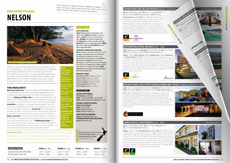New Zealand’s temperate maritime climate means that whatever the season your clients will be able to get outdoors and enjoy the activities that make New Zealand famous.
Spring (September to November)
During spring, New Zealand’s gardens put on a fantastic show of blossoms and bulbs, making it a great time to visit Christchurch, the ‘Garden City’, or any of the other destinations famous for their gardens, such as Taranaki and Hamilton. Spring skiing is popular, with plenty of snow on the slopes and warmer sunshine in which to enjoy it, and those who enjoy the outdoors will relish the opportunity to mix skiing and snowboarding one day with golfing and mountain biking the next. Farmland and forests are at their greenest and, as long as they come prepared with warm clothing and a raincoat, visitors will be able to hike or sightsee in New Zealand’s National Parks. Temperatures are pleasantly mild, warming throughout the season.
Summer (December to February)
Summer is high season in New Zealand, so crowds will be a little larger – but they are rarely big enough to impede visitor enjoyment. Many New Zealanders take holidays during summer, so holiday homes in beachside settlements will be humming with activity and seasonal cafés and galleries in remote holiday spots will open their doors for business. This time of the year is perfect for exploring New Zealand’s beautiful beaches and enjoying water sports such as swimming, surfing, sailing and kayaking. Summer is also the most popular time for game fishing in the north of the country. Settled weather and warm temperatures make it an ideal time of year for visitors to enjoy a great value camping holiday or experience a multi-day hike.
Autumn (March to May)
In autumn, summer crowds disperse but the weather usually remains settled and days warm until late in the season (though nights are cooler), making this a great time to visit. Milder weather is ideal for enjoying active adventures such as cycling and hiking, which may be more tiring in the heat of summer. Autumn also offers superb fly-fishing – cooler water means fish are more active but warm afternoons mean there are still plenty of insects for them to feed on. In certain parts of the country, such as Central Otago, the changing colours of the leaves in autumn are a spectacular sight, while wine-growing areas celebrate the annual harvest with enticing opportunities to toast the new crop of grapes!
Winter (June to August)
Winter is, of course, the perfect time to visit for those planning a ski or snowboard holiday, but even off the slopes New Zealand is a great wintertime destination and as long as visitors pack warm clothing, the landscape remains accessible throughout the year. Although the more rugged National Parks may be unsuitable for hiking through winter months, there are still lots of shorter walks to enjoy. Around Rotorua and Taupo, the trout fishing is excellent during winter, while cities and towns often enjoy a full cultural programme of theatre, dance and live music during the winter season.
Regional Temperatures - Climate Chart
Mean daily maximum/minimum temperatures in Celsius and Fahrenheit
| Spring (Sep, Oct, Nov) |
Summer (Dec, Jan, Feb) |
Autumn (Mar, Apr, May) |
Winter (Jun, Jul, Aug) |
|
| Bay of Islands | 19/9˚C I 67/48˚F | 25/14˚C I 76/56˚F | 21/11˚C I 70/52˚F | 16/7˚C I 61/45˚F |
| Auckland | 18/11˚C I 65/52˚F | 24/12˚C I 75/54˚F | 20/13˚C I 68/55˚F | 15/9˚C I 59/48˚F |
| Rotorua | 17/7˚C I 63/45˚F | 24/12˚C I 75/54˚F | 18/9˚C I 65/48˚F | 13/4˚C I 55/39˚F |
| Wellington | 15/9˚C I 59/48˚F | 20/13˚C I 68/55˚F | 17/11˚C I 63/52˚F | 12/6˚C I 54/43˚F |
| Christchurch | 17/7˚C I 63/45˚F | 22/12˚C I 72/54˚F | 18/8˚C I 65/46˚F | 12/3˚C I 54/37˚F |
| Queenstown | 16/5˚C I 61/41˚F | 22/10˚C I 72/50˚F | 16/6˚C I 61/43˚F | 10/1˚C I 50/34˚F |




 For information about advertising with us email
For information about advertising with us email